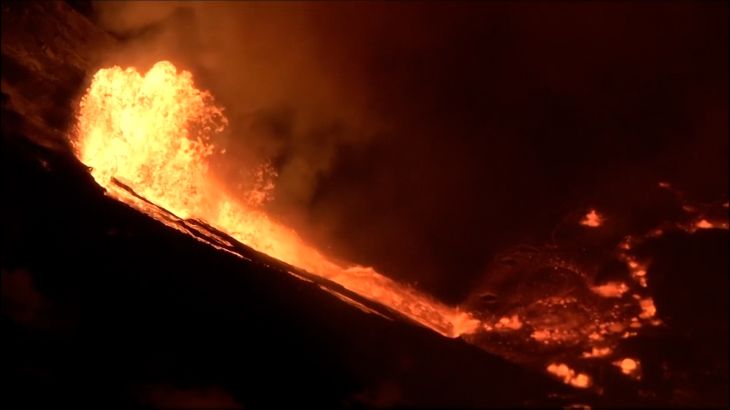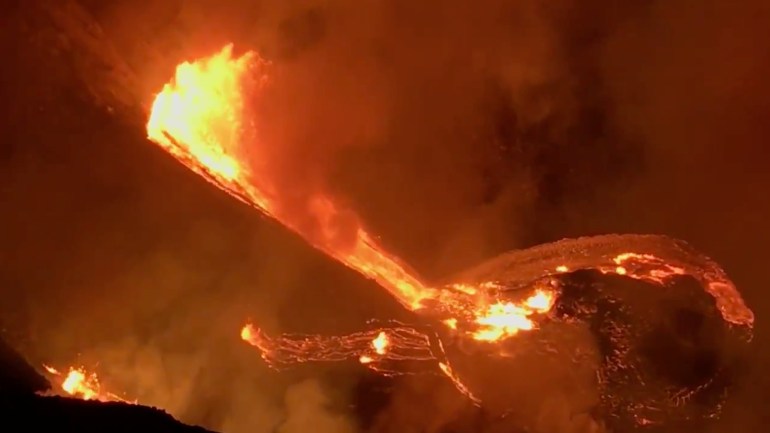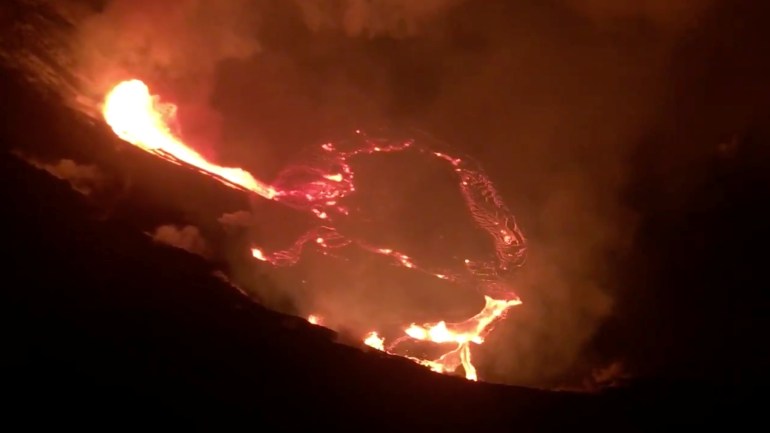Kilauea volcano erupts on Hawaii’s Big Island
The eruption started with multiple fissures opening on the walls of Halemaumau Crater.

Hawaii’s Kilauea volcano on the Big Island erupted and shot a steam and ash cloud into the atmosphere that lasted about an hour, an official with the National Weather Service said early on Monday.
It was followed by a magnitude 4.4 earthquake at its epicentre located beneath Kilauea Volcano’s south flank at 10:36pm local time (08:36 GMT on Monday), according to the Hawaiian Volcano Observatory (HVO).
Keep reading
list of 3 itemsPhilippines volcano: Restrictions lifted, thousands heading home
New Zealand: Trapped in the Volcano
Sunday’s eruption was reported at the Halemaumau Crater of the Kilauea Volcano, the Hawaii County Civil Defense Agency said on Twitter early on Monday. The agency urged residents to stay indoors.

The eruption started with multiple fissures opening on the walls of Halemaumau Crater, USGS said.
A picture from the USGS showed Kilauea’s summit illuminated by the hot lava with a plume of steam and gas bursting out of the volcano.
Tom Birchard, a senior forecaster with the National Weather Service in Hawaii, said lava interacted with a pool of water that had accumulated inside the crater, leading to a short-lived but fairly vigorous eruption.
When lava interacts with water it can cause explosive reactions.
The Hawaiian Volcano Observatory reports an eruption at the Halemaumau Crater of the Kilauea Volcano. Trade winds will push any embedded ash toward the Southwest. Fallout is likely in the Kau District in Wood Valley, Pahala, Naalehu and Ocean View. Stay indoors to avoid Exposu
— COH Civil Defense (@CivilDefenseHI) December 21, 2020
All the water evaporated out of the lake and a steam cloud shot up about nine kilometres (5.5 miles) into the atmosphere, Birchard said.
The water was the first-ever recorded in the summit crater of Kilauea volcano.
In 2019, after a week of questions about a mysterious green patch at the bottom of the volcano’s crater, researchers confirmed the presence of water. The lake had continued to fill since then.
An advisory was issued by the National Weather Service in Honolulu, warning of fallen ash from the volcano. Excessive exposure to ash is an eye and respiratory irritant, it said. The agency later said the eruption was easing and a “low-level steam cloud” was lingering in the area.
By 1am local time on Monday (11:00 GMT), USGS officials told Hawaii News Now there were reported lava fountains shooting about 50 metres (165 feet) into the sky.

David Phillips, a Hawaiian Volcano Observatory spokesman, said the agency was monitoring the “rapidly evolving” situation.
“We will send out further notifications on Kilauea and other Hawaiian volcanoes as we observe changes,” he said.
Kilauea is one of the most active volcanoes on earth, and it last erupted in 2018, destroying more than 700 homes and spewing enough lava to fill 320,000 Olympic-sized swimming pools. An area more than half the size of Manhattan was buried in up to 24 metres (80 feet) of now-hardened lava. The lava flowed over the course of four months.
The 2018 eruption occurred along a rift zone on the volcano’s flank where many residential neighbourhoods had been developed. Last night’s eruption was contained to the summit caldera within the national park.